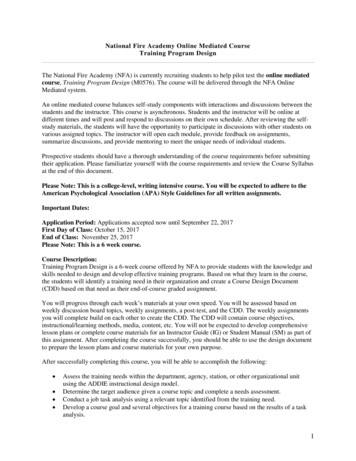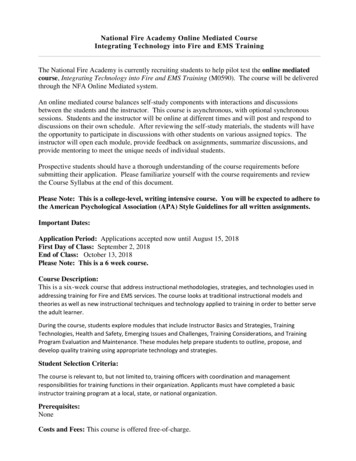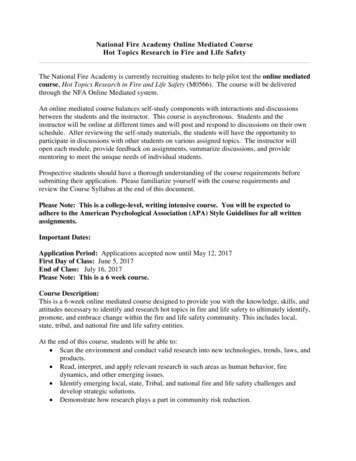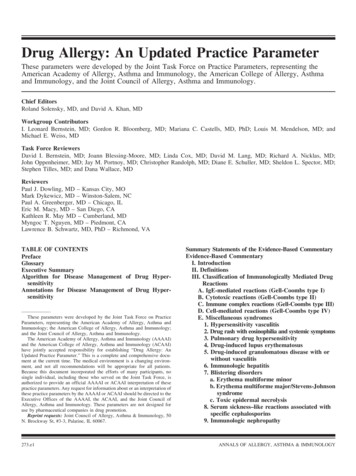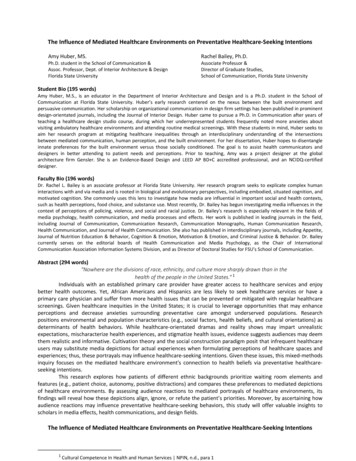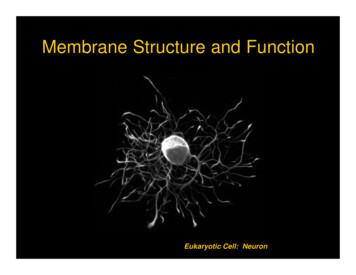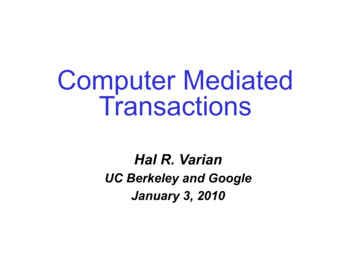
Transcription
Computer MediatedTransactionsHal R. VarianUC Berkeley and GoogleJanuary 3, 2010
Outline Waves of innovation–– Computer mediated transactions–– Combinatorial innovationWhat are implications for commerce?There is now a computer between most buyersand sellersWhat are the implications for business?Collaborative computing––There is now a computer in most officesWhat are the implications for work?
Waves of innovation Huge innovation on web in the last 15 years– Web pages, search engines, wikis, docs, maps . Why has there been so much innovation? Why has it been so rapid?Examples of combinatorial innovation–Set of component technologies that can be combinedand recombined to create new innovations1800: Interchangeable parts 1900: Gasoline engine 1960: Integrated circuits 1995-now: Internet– Shumpeter (1935), Usher (1929), Weitzman (1998), and others. –Often process takes years, or decades to play itself out,but this time it was very rapid
But this time Component parts are all bits!––– Bits/protocols/languages can be combined tomake Web pages,wikis, auctions, exchanges, video streaming,VOIP, search engines –No time-to-manufacture, no inventory problems, nodelivery problems–Bits can be shipped around the world in seconds, andinnovators can work in parallel exploring combinationsResult: extremely rapid evolution and technologicalprogressQuestion: what are implications for commerce?– Protocols: TCP/IP, HTTP, CGI, Flash Languages: HTML, XML, Java, JavaScript .Software: LAMP (Linux, Apache, MySQL, Python).
Computer mediated transactions A computer is now involved in almost everyeconomic transaction–––––Even cash registers are just PCs with a specialinterfaceB2B and web-based transactions are even morepowerful due to direct connection to a databaseOriginal intent of computer mediation was justaccountingBut the record of transactions has other usesHow does the availability of computer-mediatedtransactions affect economic activity?
What are implications? What do computer mediated transactionsenable?––––Better contractsData extraction and analysisControlled experimentationPersonalization and customization
Better contracts Contracts are fundamental to commerce–Simplest form: “I will do X if you will do Y” –Major problem: monitoring the contract –Exchange of goods, services, labor, .Sometimes performance can be directly observedBut often the quality of goods, service, actions, effort may notbe observedLarge literature in contract theory and mechanism designWhere do computers come in? Make more things observable and hence contractable Historically, advances in “information technology” have oftenenabled better measurement and monitoring Computers move this capability to a new level
Computer as accountant Since the computer servesas intermediary it can notonly serve as an accountantbut also be used to verifycontractual performance Allows us to structure moreelaborate contracts andpotentially improveeconomic efficiencyFrancesco di Marco Datini
Computer as monitor Since the computer servesas intermediary it can notonly serve as an accountantbut also be used to verifycontractual performance Allows us to structure moreelaborate contracts andpotentially improveeconomic efficiencyFrancesco di Marco Datini
Computer as verifierFrancesco di Marco Datini Since the computer servesas intermediary it can notonly serve as an accountantbut also be used to verifycontractual performance Allows us to structure moreelaborate contracts andpotentially improveeconomic efficiency Accounting computers better monitoring potentially better contracts
Rental cars Assume.––– Insurance for rental cars would cost less ifrenters drove more slowlyDrivers would be willing to drive more slowly ifthey paid less for rental carBut contract can not be made since drivingspeed can't be observedBut now.––Contract is feasible due to vehicle monitoringtechnologyEveryone is made better off (in this model)
Historical examples Mediterranean shipping 3300 BCCash registers 1883Semi trucks 1980sVideo stores 1990sOnline advertising 2000s
Mediterranean shipping 3300 BC How do you ensure that your full shipment isreceived at other end of voyage.with nowritten language?Answer–––––Match clay tokens (bullae) to jars of oil loaded onshipSeal tokens in clay envelope, stamp clay with sealBake in kiln, send with shipmentAt other end of journey, recipient breaks open theenvelope and compares tokens to jars on shipLater, inscribe marks on bullae as record of whatis inside, which may have led to writing
Examples of bullae 3300 BC
How do you ensure employees don'tsteal? From cash register––– Answer: put a bell on it1883 patent to James Rittyand John Birch for the“Incorruptible Cashier”Paper tape bell recordedtransactionsFrom truck–––Put a “vehicular monitoringsystem” on itImproves gas mileage,logistics, and honesty!Hubbard (2000)
Video store rentals Originally store purchased video tapes from studio,rented to customers–– Revenue sharing model––– But price was high, so store only bought a fewMuch unhappiness among all partiesDistributor gives videos to store at nominal priceEach time one is rented, revenue is shared according topre-specified formulaDana and Spier (2001), Mortimer (2008),But need verifiable way to count the transactions––Use bar codes, computers, and networkEach party to the transaction can verify correctness on adaily basis
Align incentives in online advertising Publisher has space for ad impression on page,wants to sell it to the highest bidder Advertiser doesn't care about ad impressions,wants clicks visitors and sales Answer– Value per impression value per click x clicks perimpression VPC x CTR– CTR is the “exchange rate” you can use to convertone to the other. How to estimate?– Huge statistical/machine learning problem– Aligns incentives between publisher, advertiser anduser Revenue sharing– Publisher and ad provider can share revenue fromclick
Example Advertiser––– Publisher– Joe's Jets and Moe's Models both want keyword “jet airplane” butthere is space for only one adJoe is willing to pay a lot per click since he makes high profit sellingjetsBut Moe gets a lot more clicks than Joe because more people buymodels than real jetsWhat publisher cares about is expected revenue price per click xexpected number of clicksAd network––Tries to estimate expected number of clicks, which (typically) allowsit to make a better choice of which ad to showSo all major search engines estimate CTRs for ad ranking, allowingpublishers to sell impressions and advertisers to buy clicks
Computer mediated transactionsmake advertising accountable A purchase can be linked back to a click or animpression, making advertising accountable–– .at least on a statistical basisAllows for optimization and tuning of purchaseprocessExamples–––––Search advertisingContextual advertisingDisplay advertisingMobile advertisingTV, radio, print more difficult due to lack of feedback
Data extraction and analysis Since online transactions are computermediated, can study data for patterns– Which converts better [diamond] or [diamonds]?– How do clicks vary over time of day?– What keywords perform best?– What advertiser characteristics predict success? Build predictive and causal models– Formulate hypotheses– Build models and estimate parameters But you don't stop there.
Controlled experimentation Data from computermediated transactionsallows for measurement–––––But it takes controlledexperimentation to determinecausalityOnline applications allow forcontrolled experiments andcontinuous improvement“Process kaizen” in 1980s nowbecomes “product kaizen”6,000 experiments in 2009, 500improvements on search aloneData vs HiPPO
Customization and personalizationComputer mediated transactions allow for “masscustomization” whereby transactions can beoptimized for individuals Purchases, searches, social interaction, etc. Most web ads are dynamically assigned Challenges ––Benefits of personalization v privacy considerationsHowever interests are not diametrically opposed Intended use: provide better services to users Unintended use: fraud, extortion, embarrassment Better security, information, transparency, usercontrol can go a long way in aligning interests
But advertising is just thebeginning. Computer mediated transactions makeadvertising accountableBut computer mediated transactions also allowfor other kinds of optimization–––– Logistics and transportation optimizationCustomer feedback and interactionProduct design and evolutionRecommender systemsImproves business processes across the boardWhat are implications for worker-to-workertransactions?
“The computer and the dynamo” Paul David (1990) onthe productivity ofelectricity– In early 1800swaterwheels poweredplants– All machineryconnected to centralshaft– Clustered machineryby type as in model
Improvements in power– Steam and then electricmotors used same design– Miniaturization of electricmotor made it possible topower each machineseparately– Allowed for rearrangement ofproduction.but no one did it. We've always done it thisway.''– Henry Ford and theassembly line offered thebreakthrough– Allowed for dramaticincreases in productivity
Henry Ford and mass production Ford realized that hecould rearrangeproduction andassembly so as tooptimize production Put the machineswhere they wereneeded, not wherethey “had alwaysbeen”
Knowledge workflow Assembly of mechanical parts– Assembly lines: optimize the flow of physicalproduct through factory in 1909Assembly of ideas–Collaborative computing: optimize the flow of ideasthrough the organization in 2009 Separation, distribution and optimization of tasksMultiauthored documents to facilitate collaborationVersion tracking and controlOvercome barriers of distance–––Outsourcing specialized tasks (McKinsey)Adam Smith's pin factory for knowledge work.and on a global scale
Enabled by “cloud computing” Evolution of computing–Mainframe –Networked workstation –Data was in one place but access was controlledData in work group, direct accessPersonal computer Direct access, data mostly on single computer or LAN– Network computing –Data on network, direct access but mostly for downloadCloud computing Direct access, data lives in cloudStore once, read everywhere, write anywhere via the WebAccess from any device, at any time, by any authorized user
Infrastructure for rent Barriers to entry for online businesses havebeen dramatically reduced––––Can purchase computation in data center, storageon demand, development environment and databaseservices from cloud computing providersTurns fixed cost into variable costAllows you to smoothly scale your business to meetcustomer growthPushes “combinatorial innovation” to a new level Not only innovation is combinatorial, but now actualdeployment!Can foster a huge burst of creative activity
Micromultinationals Cheap communications– SMEs now have access to communicationstechnology that only the mega-multinationals couldafford a decade ago– Email, webpages, wikis, VOIP, wireless,collaborative computing, cloud computing– Opens doors to small business around the world Combinatorial innovation– Businesses can be born international– Fosters huge parallel innovation in both technologyand commerce– This is only the beginning.
The End
Appendix Various unused slides below
Early attempt to optimize knowledgework with hypertext.
Disassembly line
Computer mediated transactions A computer is now involved in almost every economic transaction - Even cash registers are just PCs with a special interface - B2B and web-based transactions are even more powerful due to direct connection to a database - Original intent of computer mediation was just accounting - But the record of transactions has other uses
